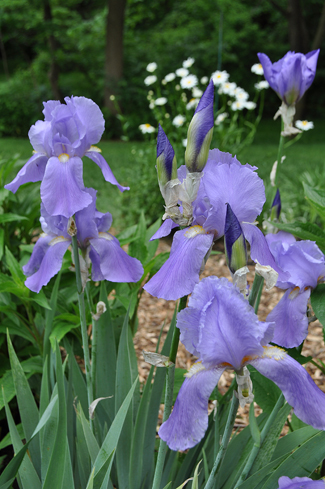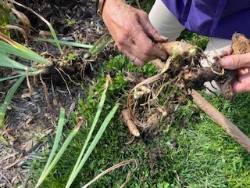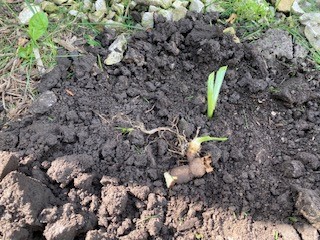Summer is the Best Time to Plant, Move or Divide Iris
 Hot and humid conditions do not sound like a good time to garden. If you are a lover of iris, forget about the weather as there is work to be done.
Hot and humid conditions do not sound like a good time to garden. If you are a lover of iris, forget about the weather as there is work to be done.
Late July through mid August is the best time to plant, move or divide iris. Iris is one of the most popular perennials in the garden and easy to grow. Although they provide pleasure for many years with little care, periodic dividing is an important cultural practice for maintaining plant health.
When to Divide Iris
As a general rule, iris should be divided about every three to five years. Without timely dividing, the plants simply outgrow their allotted space in the garden. Normally, the bloom quality of the clump decreases when the plants become overcrowded.
How to Divide Iris
There is no simple way to approach a clump of overgrown iris but to just jump in and tackle it. Start by digging the entire clump. The good news is, the plants have a fairly shallow root system so digging deep is not needed. If conditions are dry, be sure to water one or two days before to moisten the soil for easier digging. Once out of the ground, start breaking the plants apart. Iris rhizomes are vigorous and almost indestructible. Knock the soil off the roots and break and pull the rhizomes apart. There will be more divisions than anyone could possibly use so discard small roots. Iris rhizomes grow out. The old rhizome furthest away from the fan of leaves can be discarded. All that is needed is the last knee or bump attached to the leaves. The rest is old unproductive rhizome that is not needed for a healthy plant. Many prefer to cut the leaves back about one-half to make the plant more manageable.
Once out of the ground, start breaking the plants apart. Iris rhizomes are vigorous and almost indestructible. Knock the soil off the roots and break and pull the rhizomes apart. There will be more divisions than anyone could possibly use so discard small roots. Iris rhizomes grow out. The old rhizome furthest away from the fan of leaves can be discarded. All that is needed is the last knee or bump attached to the leaves. The rest is old unproductive rhizome that is not needed for a healthy plant. Many prefer to cut the leaves back about one-half to make the plant more manageable.
How to Plant Iris The hard part is now done. Replanting the iris rhizomes is easy. Prepare the soil by spading an ample supply of compost or peat moss to help break up the hard clay soils commonly found in our area. Iris rhizomes should be planted very shallow. Cover only the bottom half of the root and leave the top exposed to the sun. A nice size division, or start, is a grouping of about three prepared rhizomes. Point the leaves outward in a circle and lightly cover. Thoroughly water and the process is done.
The hard part is now done. Replanting the iris rhizomes is easy. Prepare the soil by spading an ample supply of compost or peat moss to help break up the hard clay soils commonly found in our area. Iris rhizomes should be planted very shallow. Cover only the bottom half of the root and leave the top exposed to the sun. A nice size division, or start, is a grouping of about three prepared rhizomes. Point the leaves outward in a circle and lightly cover. Thoroughly water and the process is done.
Sit back and wait until next May for a wonderful reward of iris blossoms. Enjoy one of the area’s easiest to grow perennials. There is nothing finer than a graceful iris blossom.

